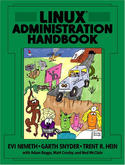Book Review: Linux Administration Handbook

If you are familiar with the Unix System Administration Handbook, you already are familiar with the subjects this new book is addressing. Much like Linux being a re-implementation of UNIX, this book is a re-implementation of the Unix SA Handbook. But, things get better.
So many of the available books about Linux are either too generic to be of much use for doing serious systems administration or so specific that they are useful only for one version of one Linux distribution. This book is an exception. First, it is heavy on concept, so you actually learn how things work instead of learning how to be a technician. The specifics are then addressed by showing what you do on Red Hat 7.2, SuSE 7.3 and Debian 3.0.
The scope of the book does not stop at what is inside a Linux box. Don't be surprised when you start reading what various routing protocols are, what the different Ethernet cable colors are supposed to mean or how to configure a Cisco router. This book tells you how to administer a company that has Linux systems, not just how to administer Linux systems.
You will also find liberal references to other reading materials and exercises at the end of each chapter. Considering this book is close to 900 pages of useful information, the references are helpful but daunting.
The book doesn't assume you know much about systems administration. It's good if you do know a bit, but don't shy away for the book if you are a Linux user with little or no SA experience. The authors start at the beginning and build.
There are 29 chapters in the book, starting with some Linux background and taking you through policy and politics. In between you will find excellent coverage of booting and the related scripts, process control, filesystems, user administration and the usual hardware stuff, including serial and disk. Then it's on to backups, logs and drivers.
The next part of the book talks about networking and covers TCP/IP, routing, network hardware, DNS, NFS, NIS, e-mail, network management, security and web hosting. When I say it "covers" these topics, I don't mean it merely gives you some internal Linux commands; instead, it tells you what you need to know to get the Linux system talking to the world.
The last part, titled "Bunch O'Stuff", is a collection of other useful information, such as software installation, printing, maintenance, performance analysis, cooperating with Windows and dæmons.
I really don't see anything that is left out of this book. In the few cases where I needed to know more, the references quickly pointed me to additional information. Overall, the book is well written, complete and up-to-date. If you need to learn about Linux administration or simply want a great reference, buying this book will be the best $50 investment you could make.
Phil Hughes is the publisher of Linux Journal.
email: phil@ssc.com






